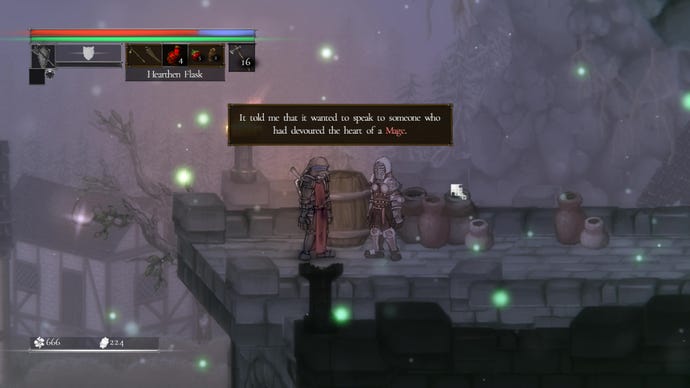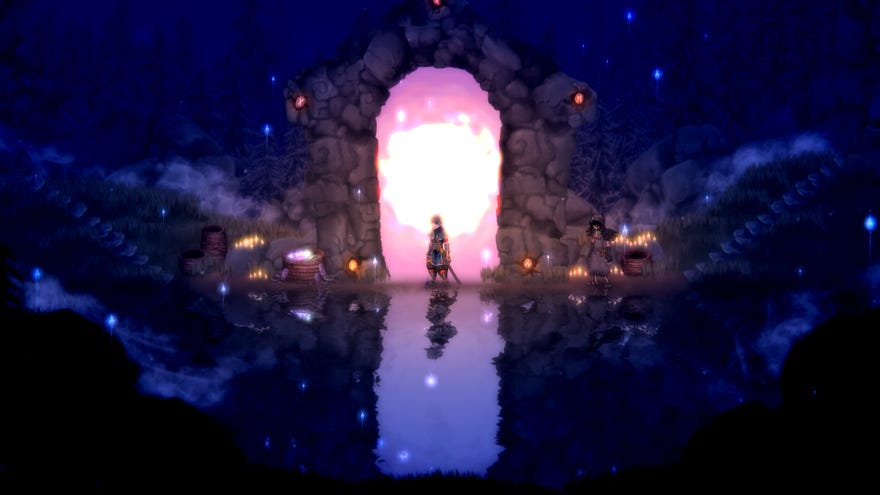With mage hunts and talking trees, Salt And Sacrifice is looking like a worthy successor to Salt And Sanctuary
Worth its salt, I reckon
If you liked Dark Soulsy side-scroller Salt And Sanctuary, I have some great news. I got hands-on with an early portion of its sequel Salt And Sacrifice, and it seems set to deliver all the things that made its predecessor tick. The punishing enemies, the smooth combat, the vast skill trees, and the interconnected world are all still doing good things, but this time around they've just been joined by a few new additions, or seen some tweaks to keep things fresher, but no less difficult.
To set the Soulslike scene, Salt And Sacrifice is a 2D sidescroller that riffs heavily off Dark Souls and its gothic, perilous world. We're talking crumbled castles and misty caverns, littered with wretches feasting on corpses, or ultimately, looking for a fight. Of which I had many in the hour or two I spent in the game's earliest areas.
Start a new game in Salt And Sacrifice and you'll be faced with a familiar character creation screen. Here, you can select one of eight classes, customise your appearance, and decide what sort of crime you've committed. You're an indebted criminal, you see, and therefore doomed to be a Marked Inquisitor, which is fancy speak for someone who hunts mages. Get so much as a whiff of a mage in this game and you'll go after them.
I went down the Fighter route, which outfitted me with some heavy armour, a sword and shield, alongside some weighty throwing axes. My crime? Brigandry, because highway robbery seemed fitting for this build. Although, what difference your crime makes is unclear. I started multiple playthroughs, selected all sorts of misdeeds, and it only altered some text in the intro sequence. Perhaps your drunkenness or arson has different consequences later?
Still, the game's classes all felt rather distinct, at least in the early portion I played. Combat is punishing, as even standard goblins are capable of cutting you down in just a few hits. My Fighter was clunky, but powerful; slow rolls followed up with big swings. I had to make sure I timed my blocks and dashes well, otherwise I'd die pretty quickly despite my chunky armour. As a Duelist, in contrast, I was nimble and could dance around enemies with quick dashes. My katana was equally fast and choppy, but didn't hit quite as hard as my Fighter's axe.

But much like the previous game, your starting class in Salt And Sacrifice won't lock you into a particular playstyle if you don't want it to. Once you've earned enough Salt from fallen enemies, you can head on over to an altar to level up, as well as allocate points into a sprawling skill tree. Not much has changed here, but that's fine. There's plenty of choice for those who'd like to steer their class in a totally different direction, add some complexity, or just keep it simple.
This altar is located in a hub space that's also home to NPCs that'll trade items, upgrade things, and hint at where you should head next. It's also here where you'll find one of Salt And Sacrifice's most important new additions: the Arch. Essentially, it's a teleporter that'll take you to places where evil mages lurk, though you have to spell out the location in Runestones for the Arch to whisk you there. Progression seems to be tied to exploring areas and clearing them of mages, thus unlocking new locations to spell out at the Arch, visit, and clear of mages.

All this hunting mages business is new to the series too. Salt And Sacrifice has 'normal' boss fights, with hulking brutes that'll block your path unless you tackle them - for instance, I faced off against a large lad with a whopping great axe - but there are Hunts too, which have you follow a wispy, dark trail in search of a powerful mage. In my case, I needed to devour the heart of a pyromancer named "Arzhan-Tin", who engulfed Ashbourne Village in fire. Come on Tinny, there's just no need for that.
Hunting Arzhan-Tin was pretty fun, albeit a touch unclear at times. It was a bit stop starty, with no clear endpoint to begin with. I bumped into Tinny a number of times, once in the village, once in the depths of some mines, and again on a wooden platform of sorts. I could smack him during these pit stops of his, but wasn't sure if I was damaging him or not. Each time, he'd summon some fire, maybe some enemies for me to deal with, and piss off into the ether. It was only when Tinny stopped on a large, flat, "this is a boss arena" surface that the game explicitly said: "Now you may fight Tinny". Finally, some clarity. Although I was a bit miffed that all those times I'd wailed on him had amounted to nothing.

Thankfully, the final showdown with Arzhan-Tin was a decent slugfest. As a towering pyromancer, he'd try and engulf me in towers of flame, or opt for the classic flamethrower technique. If I got too close, he'd swipe at me with a blazing sword. After numerous failed attempts to battle him head-on, I went for the run-away-and-lob-axes approach, which worked a charm. Tinny went down, I devoured his heart, and the hunt was ticked off.
My reward for Tinny's demise? Seemingly, a great deal. There are glowing red doors in the world which require a certain number of mage hearts devoured for use. Step through them and they'll often lead to more hunts, new areas, and tougher enemies. Perhaps more importantly, casual raw cannibalism proved me worthy to certain NPCs in Ashbourne Village, mamely a tree with a face. It mentioned a new location - although it explicitly stated that it couldn't tell me how to get there because this was a demo. At least it was honest.
My very small slice of Salt And Sacrifice left me with many questions. How is the Arch tied to progression? How do I used the materials gathered from hunts? What's the deal with that tree? But overall, it proved to be a decent time. It's a world I'd like to dive deeper into, and that's what matters, really. Despite my short play time, I can already see this shaping up to be an unmissable follow up for Salt And Sanctuary fans.


